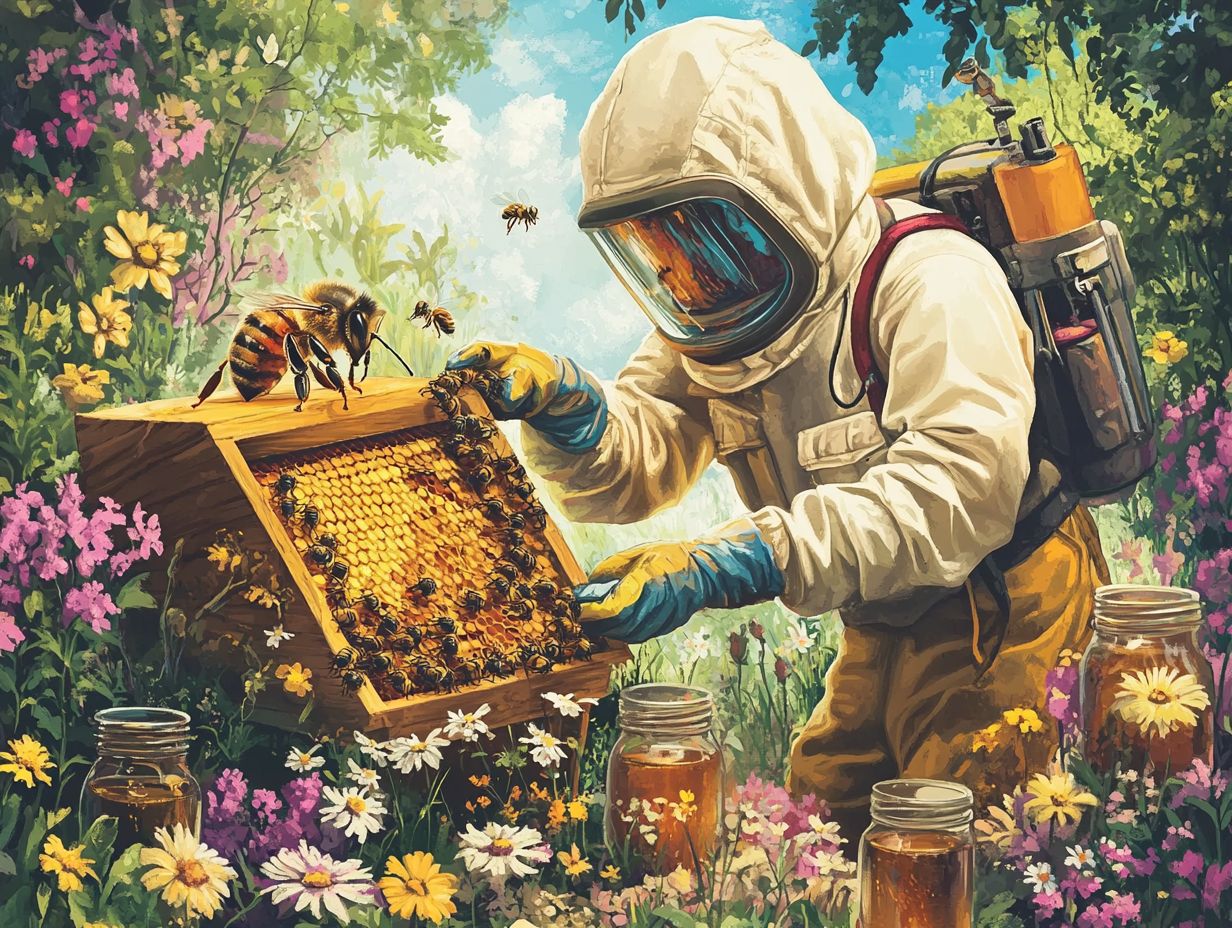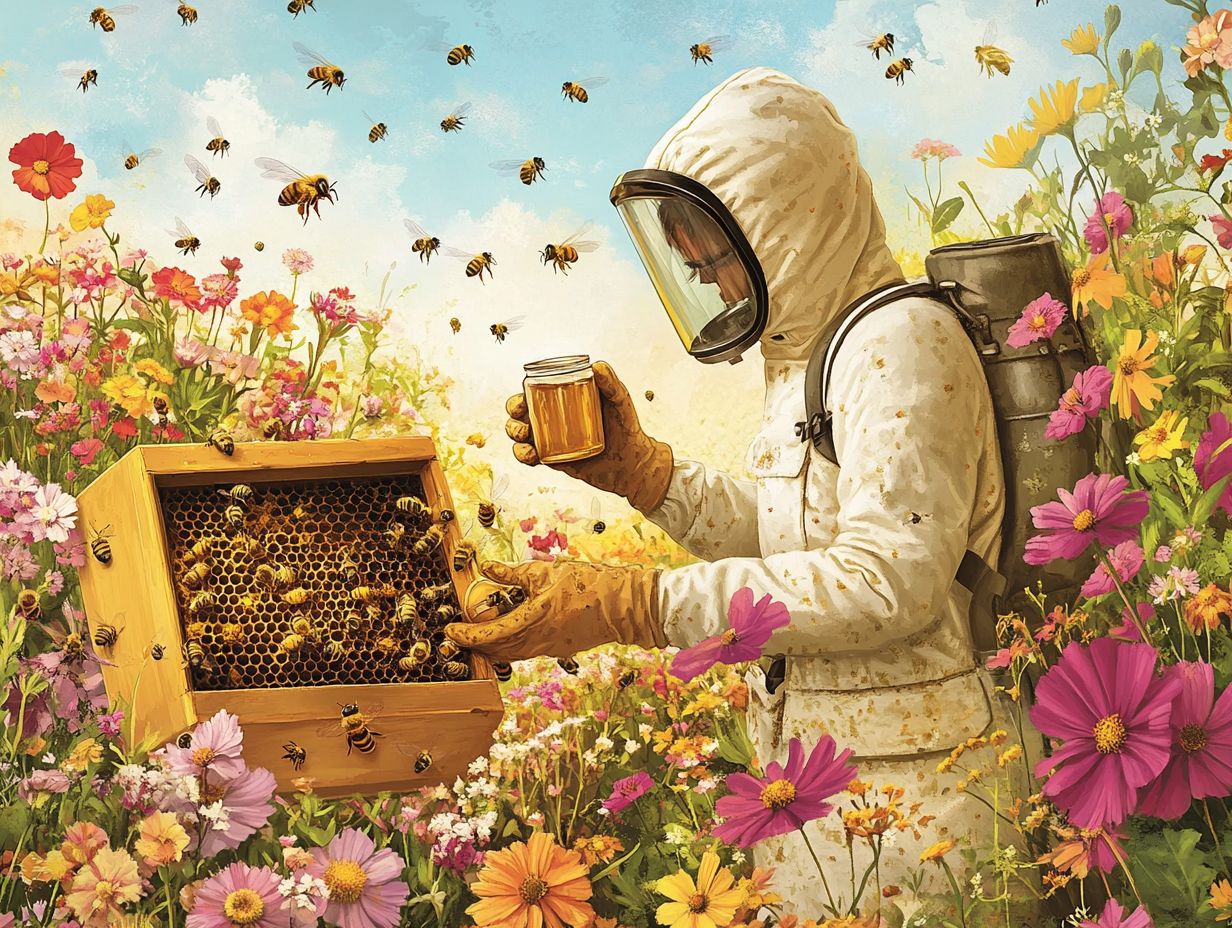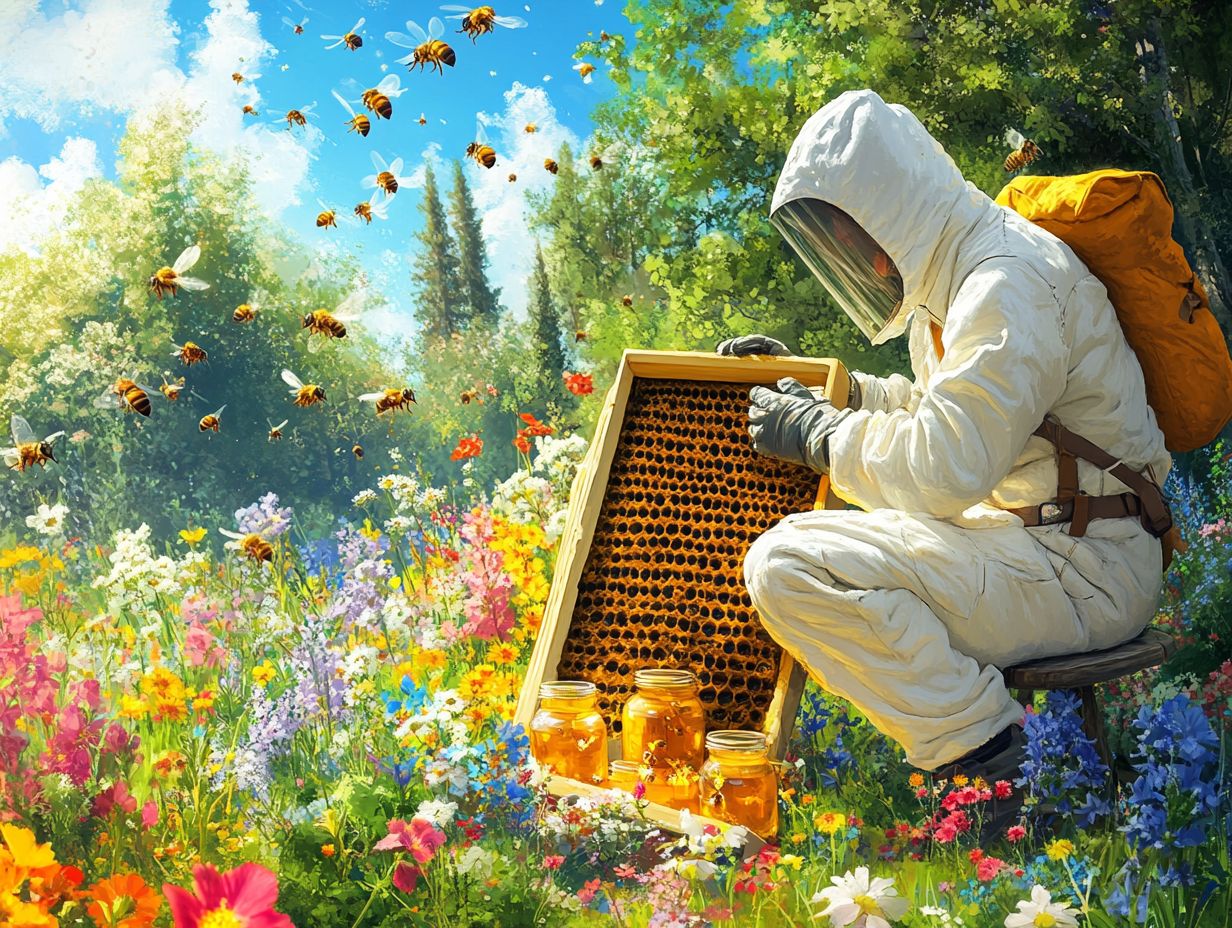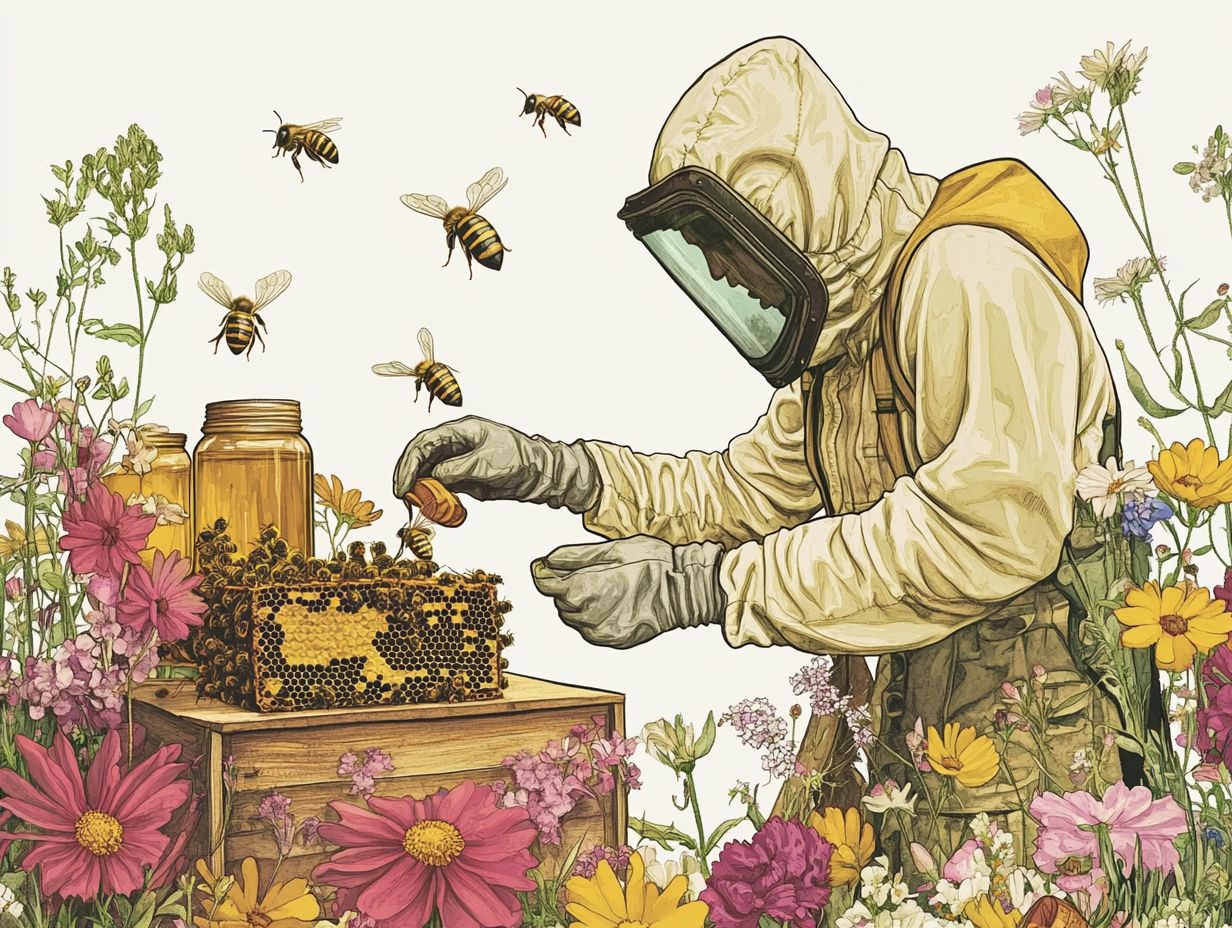How to Promote Higher Honey Yields
Honey yields are pivotal in the beekeeping industry, influencing both the economy and the sustainability of our environment, particularly through sustainable beekeeping practices.
By grasping the factors that affect these yields—such as your beekeeping practices, local weather conditions, and the availability of floral resources—you can significantly enhance your harvest.
This article delves into key strategies for increasing honey production, covering everything from effective hive management to creating bee-friendly habitats, including the use of a queen excluder and supering techniques.
You’ll uncover the myriad benefits of higher yields, including better bee health, superior honey quality, and increased honey crop output.
Dive into these insights now to supercharge your beekeeping success!
Contents
Key Takeaways:
- Proper beekeeping practices, such as providing adequate nutrition and managing hive health, are crucial in promoting higher honey yields.
- Rotating hive locations and planting bee-friendly flowers can also significantly increase honey production.
- Higher honey yields lead to increased profits and better quality honey, while also contributing to improved bee health, robust colonies, and more sustainable beekeeping practices.
What is the Importance of Honey Yields?
Honey yields are vital not just for the economic sustainability of beekeeping but also for fostering healthy ecosystems and supporting vital pollinator populations.
Your ability to produce high-quality honey significantly influences your financial returns, as many beekeepers depend on honey production as their primary income source.
Higher honey yields make colony management easier, allowing you to adopt sustainable practices that benefit both your hives and the environment.
As demand for honey continues to rise, recognizing the importance of honey yields becomes crucial for developing effective beekeeping strategies.
Factors Affecting Honey Yields
Several factors influence honey yields, so it’s crucial for you to understand and manage these variables effectively, including climate impact and seasonal management.
Key elements include beekeeping practices that optimize hive health and productivity, weather conditions that dictate nectar flow and pollen availability, and the diverse floral sources that deliver essential nutrients for your honey bees.
Effective pest and disease management is vital for ensuring the longevity of your colonies and sustaining high levels of honey production.
1. Beekeeping Practices
Effective beekeeping practices are crucial for maximizing your honey yields and ensuring the health of your colonies.
Techniques like proper hive management, swarm prevention, and strategic queen management can significantly impact the productivity of your honey bees, particularly the worker bees that are essential for nectar foraging and honey production.
Regular hive inspections help you monitor colony health and catch potential issues early. This proactive approach can prevent declines in honey output.
Implementing swarm prevention strategies, such as ensuring there’s adequate space in the hive and managing brood patterns, will help maintain a stable and efficient workforce.
Managing the queen bee means ensuring she is healthy and able to lay enough eggs. Timely requeening and tracking the queen’s performance ensures that a strong, vibrant queen continues to lay eggs, sustaining the worker bee population needed for optimal foraging.
Each of these tailored practices contributes to a thriving hive, ultimately boosting your overall honey yield.
2. Weather Conditions
Weather conditions are crucial for your honey yields. They directly impact nectar flow and pollen availability.
Elements like temperature, humidity, and rainfall significantly influence flowering plants. This, in turn, affects your bees’ foraging behavior.
By implementing effective seasonal management that aligns with prevailing weather patterns, you can enhance honey production and secure better yields.
For example, warm temperatures typically trigger increased nectar production, resulting in a richer food source for your bees. Conversely, extreme heat can create drought conditions that may reduce flower availability, ultimately diminishing your honey output.
Seasonal variations are equally critical. Early springs or late frosts can disrupt the blooming timeline of plants, affecting the nectar flow you depend on.
By closely monitoring these weather factors, you can adapt your beekeeping practices strategically. This allows you to optimize hive placement and ensure that your bees have access to the finest food sources throughout the flowering season.
3. Floral Sources
Floral sources are essential for your bees’ nutrition and impact honey yields. The availability of nectar determines how much honey you can harvest.
By cultivating diverse pollinator plants, you support the health of your bee colonies. This enhances the economic viability of your beekeeping efforts, boosting both the quantity and quality of your honey production.
When your bees have access to a variety of flowering plants, including wildflowers and cultivated species, they can enjoy a well-rounded diet packed with essential nutrients. This diversity is vital; certain plants provide specific types of nectar that can influence the unique flavor and color of your honey.
Consider incorporating these beneficial pollinator plants into your landscape:
- Clover
- Sunflowers
- Lavender
These plants are bee magnets! They flourish in various environments and can significantly influence bee foraging behavior, leading to more efficient pollination and, ultimately, higher yields.
In the end, nurturing a rich floral landscape is crucial for the health of your bee populations and the productivity of your beekeeping operation. Start nurturing a rich floral landscape today for the health of your bee populations and your beekeeping success!
4. Pest and Disease Management
Effective pest and disease management is vital for maintaining honey yields. It ensures the overall health of your hive.
Pests like varroa mites and comb pests can severely reduce colony productivity. Proactive measures are necessary to combat these threats.
By implementing combined pest control methods, you protect your bee colonies and enhance honey production, ensuring your bees stay healthy and capable of efficient foraging.
Understanding the life cycle of specific threats, like varroa mites, is vital for developing effective control methods. These parasites latch onto adult bees, feeding on their bodily fluids and weakening the hive, making it more susceptible to diseases.
To counteract their devastating effects, you should adopt practices such as:
- Regular hive inspections
- Using screened bottom boards
- Introducing mite-resistant bee stock
You can also use natural predators and organic treatments to maintain a balanced ecosystem within the hive. This helps your bees thrive without interfering with honey production.
How to Increase Honey Yields?
To increase your honey yields, you must adopt a multifaceted approach that encompasses bee nutrition, hive health management, and strategic harvesting techniques.
Ensuring a sufficient supply of nutrients for your bees is essential, alongside maintaining the overall health of the colony through effective hive management practices.
Employing tools such as queen excluders can streamline your honey extraction process. Cultivating bee-friendly flowers will significantly enhance foraging opportunities for your bees.
1. Provide Adequate Nutrition
Providing adequate nutrition is essential to boost honey yields. The availability of pollen and nectar sources directly influences the health and productivity of your bees.
When your bees have a well-balanced diet, they can perform at their best. This leads to enhanced honey production and overall colony success.
The diversity of pollen and nectar is key. Different floral sources offer a range of essential nutrients, including proteins, lipids, vitamins, and minerals.
For example, protein-rich pollen from plants like clover significantly aids in bee brood development. This ensures a strong workforce for foraging and hive maintenance.
Nectar from various floral species, with their differing sugar concentrations, plays a crucial role in energy provision. This impacts foraging efficiency and honey concentration.
Cultivating a variety of flowering plants supports strong bee colonies and enhances honey flavor. It makes the honey more appealing to consumers.
Thus, grasping the connection between bee nutrition and honey yields is vital for you as a beekeeper and in the context of environmental conservation.
2. Manage Hive Health
Proper hive health management is essential for maximizing honey yields. Ensuring your colony remains strong and productive throughout the season is crucial.
Techniques like effective comb management and maintaining a healthy brood chamber can greatly influence your hive’s ability to store and produce honey.
Regularly inspecting and replacing old or damaged comb promotes better hive ventilation and reduces the risk of disease and threats from pests like the Small Hive Beetle.
Keeping the brood chamber organized and free from excess clutter allows your worker bees to focus on nectar and pollen foraging more efficiently.
These practices support the growth of a robust bee population and cultivate a thriving environment for honey production. Beekeepers who prioritize hive health management notice a significant increase in honey yields.
3. Use Queen Excluders
Act now by using queen excluders to boost your honey production. This simple step can transform your hive’s efficiency.
Utilizing queen excluders prevents the queen from laying eggs in the honey supers. This optimizes that precious storage space for pure honey.
This technique is particularly advantageous for hive management, allowing you to establish double queen or two-queen colonies, thus enhancing your hive’s productivity.
By implementing this method, you create a clear separation between the brood area and the honey storage zone.
This ensures that the honey you harvest remains free from larvae and uncapping issues, prioritizing bee health.
Queen excluders also promote a more organized hive layout, making inspections and maintenance tasks much simpler. With the queen confined to the designated brood chambers, your honey bees can concentrate their foraging efforts on collecting nectar.
Using excluders reduces the likelihood of swarm behavior, enabling you to manage population dynamics more effectively. This contributes to a robust honey yield throughout the season.
4. Rotate Hive Locations
Rotating hive locations is a strategic practice in beekeeping that can significantly enhance your honey yields by optimizing access to nectar flow and forage availability.
This technique proves especially beneficial in migratory beekeeping and farm management, where you can move hives to different areas based on seasonal floral availability, especially for crops like Chinese tallow.
By intentionally relocating your hives to diverse environments, you can fully capitalize on blooming periods across various flora. This not only boosts the availability of nectar but also enhances the overall health of your bee colonies, as bees flourish in locations rich in resources.
Implementing this technique requires careful planning, including monitoring local blooming cycles and understanding regional microclimates (small areas with different weather conditions). Rotating your hives can reduce the risk of diseases and pests that tend to thrive in stagnant locations, fostering a more robust and productive bee population.
Ultimately, these strategic movements can lead to a remarkable increase in honey production, benefiting both you as a beekeeper and the ecosystem at large.
5. Plant Bee-friendly Flowers
Planting bee-friendly flowers is vital for your success! These plants serve as vital nectar sources and provide ample pollen for honey bees.
By cultivating a diverse array of pollinator plants, you can create an inviting environment for foraging, ultimately leading to increased honey production.
Flowers like lavender, sunflowers, and clover are particularly celebrated for their high nectar content and long blooming periods, ensuring a consistent food supply. These blossoms not only attract bees but also offer valuable nutrients that support their health and vitality.
Incorporating native wildflowers into your landscape can significantly bolster local bee populations, as these plants are well adapted to your region and often provide abundant pollen resources.
By thoughtfully selecting and planting these varieties, you can enhance both the quality and quantity of the honey you harvest while simultaneously promoting sustainability in beekeeping practices and biodiversity through planting native wildflowers in your ecosystem.
Start planting these flowers today to give your bees the boost they need!
6. Proper Harvesting Techniques
Implementing proper harvesting techniques is essential for maximizing your honey yields and ensuring the quality of the honey you extract. By combining efficient honey extraction methods with effective comb storage practices, you can significantly enhance both the productivity and profitability of your beekeeping operation.
Understanding the right timing for your harvest is crucial. It guarantees that the honey is fully ripened and boasts the best flavor profile.
Utilizing a honey extractor can help you minimize damage to the wax combs, which is vital for sustaining a healthy hive. Proper storage of honeycomb allows you to preserve the fruits of the bees’ labor while maintaining the honey’s natural characteristics that reflect the bees’ environment.
By integrating these techniques, you not only elevate the quality of your honey but also promote healthier bee populations, contributing positively to the ecosystem.
7. Reduce Stress on Bees
Reducing stress on bees is crucial for maintaining hive health and maximizing honey yields. Stressed bees can show decreased foraging efficiency and overall productivity. By implementing effective comb management and practicing mindful seasonal strategies, you can significantly alleviate stressors, resulting in healthier and more productive colonies.
Regularly inspecting and rotating comb ensures that your bees have sufficient space and resources to thrive, minimizing overcrowding and reducing the risk of disease.
Seasonal practices, such as providing supplemental feeding during dearth periods and preventing excessive moisture in the hive, are vital for nurturing a resilient bee population.
These intentional strategies not only bolster bee health but also enhance honey production, leading to more robust harvests and a flourishing beekeeping operation.
Ultimately, dedicating time to these practices fosters a sustainable environment where both you and your bees can thrive.
What Are the Benefits of Higher Honey Yields?
Higher honey yields offer significant benefits for both beekeepers and the ecosystem. They go beyond financial gains and allow you to invest in better equipment and sustainable practices.
This investment improves bee health and elevates the quality of your honey.
1. Increased Profits
Higher honey yields directly impact your profits as a beekeeper. As your production increases, expect better financial returns, enabling you to reinvest in your operations.
More revenue lets you buy superior equipment and improve hive management. You can even explore value-added products like beeswax and propolis!
2. Improved Bee Health
Better honey yields enhance bee health as strong bee colonies can forage and produce honey effectively. By prioritizing good pest control and strong colonies, you create an environment that supports impressive honey production.
Diverse planting strategies enrich your bees’ food sources. Organic pest control safeguards bee health and protects the environment.
3. Better Quality Honey
Higher yields can lead to better quality honey! Careful management enhances flavor and product characteristics.
This focus on quantity and quality boosts your honey’s market appeal. Good pest control, proper nutrition, and choosing excellent genetics all enhance your honey’s attributes.
By adopting sustainable beekeeping methods, you can influence nectar diversity, leading to unique taste variations.
Strive for excellence in both yield and quality. You play a vital role in enhancing the honey industry’s reputation and sustainability.
4. Sustainable Beekeeping Practices
The adoption of sustainable beekeeping practices is essential for achieving higher honey yields while minimizing your environmental impact. By focusing on strategies that support bee health and foster pollinator-friendly habitats, you can enhance production without compromising the integrity of the ecosystem.
This approach not only boosts your honey output but also ensures the well-being of the bee population. Implementing practices such as crop rotation (the practice of alternating crops in your fields to improve soil health), natural pest control, and creating diverse flowering habitats can significantly improve the overall health of your bee colonies.
Provide bees with access to clean water sources. Maintaining proper nutrition by supplementing their diet during forage shortages is a critical strategy to consider.
By embracing these environmentally conscious methods, you contribute to thriving bee communities that are resilient to pests and diseases. This ultimately results in improved honey quality and quantity.
Frequently Asked Questions
How can I increase my honey yields?
Understanding beekeeping techniques can enhance your honey production. To promote higher honey yields, there are several steps you can take:
- Ensure your beehives are located in areas with abundant nectar sources, such as near fields of flowering plants.
- Regularly check and maintain your hives to keep them healthy and free of pests.
- Consider supplementing your bees’ diet with sugar water or pollen patties to encourage honey production.
Does the type of bees I have affect honey yields?
Yes, the type of bees you have can impact honey yields. Some bee species, such as Italian bees, are known for their high honey production, while others may produce less. Research the characteristics of different bee species before choosing which ones to keep for honey production.
How often should I harvest honey to promote higher yields?
The frequency of honey harvesting depends on several factors, such as the size of your hives, the strength of your bee colonies, and the local climate. Generally, it’s best to harvest honey once or twice a year, allowing your bees enough time to replenish their honey reserves and continue producing more.
Are there any natural methods to promote higher honey yields?
Yes, there are several natural methods to promote higher honey yields. Planting a variety of flowers and plants near your hives provides a diverse source of nectar. You can also use organic pest control methods, such as introducing beneficial insects or using natural oils, to keep your hives healthy and increase honey production.
Can weather conditions affect honey yields?
Yes, weather conditions can significantly influence honey production. Consistently cold, wet, or windy weather can prevent bees from foraging for nectar and decrease honey production. In contrast, warm and sunny weather encourages bees to produce more honey. Keep an eye on the weather—it can make a big difference!
What should I do with my honey after harvesting it?
After harvesting your honey, act quickly to store it right—this keeps it fresh and delicious! Use clean, dry containers, and store your honey away from direct sunlight in a cool environment. Consider using specialized equipment, such as honey extractors, to remove impurities and improve the taste of your honey.




